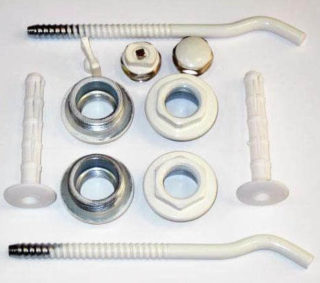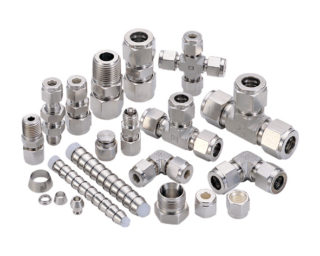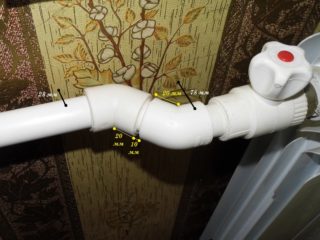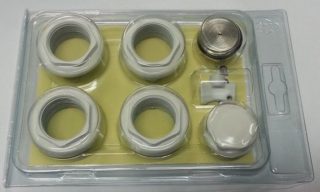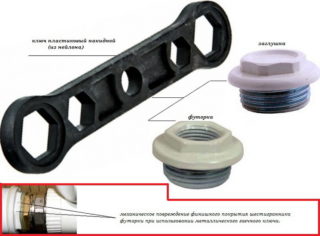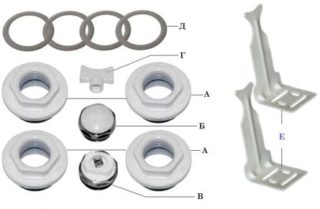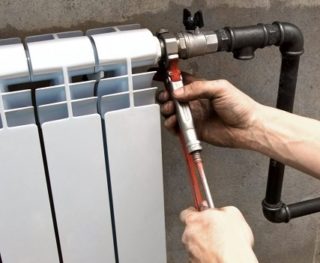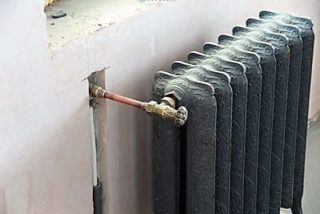A thermal convector for water heating comes on sale with mounting holes for connecting to the circuit, which go up and down on both sides. But in order to insert such an element into the overall system, certain associated fittings are needed. A mounting kit for a heating radiator provides everything you need for these purposes. There are also kits that allow you to fix the heater on the bearing surface of the wall.
Types of mounting parts
The options for connecting thermal convectors can be different:
- diagonal connection;
- sidebar insertion;
- docking at the bottom along the edges.
Depending on this, accessories are also chosen. According to the diameter of the screw connection of the latter, it is necessary to purchase one or another version of the radiator connection kit. The main difference between the two is that the diameter of the external thread can be half an inch or three quarters.
To fix the hanging convector on the wall, there are also various fastening sets - brackets, pins and corners. The first two types of brackets are used on walls made of brick, cinder block and similar structures, corners - when installing batteries on wooden surfaces.
For connecting radiator batteries ½
Mounting kits for a radiator go on sale without brackets for suspending heat collectors. There are six spare parts in the package and they are designed to work with any type of battery made of bimetal, aluminum alloys and steel, the dimensions of which correspond to 0.8-0.35 meters in height, and the type of the collector mounting hole at the bottom and top is defined as G1 ”(internal). The adapters themselves are internally threaded for connection to half-inch valves.
Fittings are designed to work only with liquid heat carrier water or antifreeze, which in composition do not contain components that destructively affect the sealing rings. The normal functioning of the elements is guaranteed at an internal pressure of the system not exceeding 16 bar.
The internal threading of such products has a diameter of half an inch. The installation of the footings on the seats must be carried out with a force not exceeding 25 Nm, the Mayevsky crane and plugs during installation are tightened with less force - 20 Nm.
To connect radiator batteries ¾
Similarly to the radiator kit described above, a three-quarters internal thread kit can be installed on almost all types of heat convectors working on liquids; the technical requirements for installation are the same. The package contains six mounting accessories and a key for the Mayevsky crane.
The adapters, air vent valve and plug are made of brass coated with nickel and polypropylene. All elements of the external part of spare parts have silicone seals for quick installation, the legs themselves are hermetically screwed into the batteries using fum tape or special sealants that can withstand temperatures up to 100 degrees Celsius. Each threaded insert is equipped with a hexagon for convenient screwing with a spanner or adjustable wrench.
When using flax thread as a sealant, it is important not to overdo it with its layer, otherwise this can lead to destruction of the accessory case.
What is included in the installation kit
Usually a standard kit for connecting a radiator provides the following list of elements:
- left foot (adapter) with a sealing ring - 2 pcs;
- right foot with o-ring - 2 pcs;
- plug for adapter of self-sealing design;
- Mayevsky crane with silicone gasket;
- special air vent key.
A more versatile kit for mounting a radiator may include brackets for fixing the housing seats to the wall. These fasteners are different in accordance with the type of convector used in heating.
Futorka
A fitting that has a thread inside and outside a short length of pipe that resembles an ordinary bolt in shape. This part is involved in the connection of valves and various pipes, when you need to make the transition from a larger diameter to a smaller one or vice versa, as well as to adapt the heater with standard pipe fittings. Plumbing adapters are made of bronze and its alloys.
In some cases, when the screw thread is destroyed in a steel hole, it is drilled and a brass fitting is installed in this place. This allows you to extend the life of water equipment.
Mayevsky air vent
An original design crane installed laterally at the top of a liquid heat convector to remove air from it. The device has a brass base with a thread for mounting and a thin hole in the middle. Outside, there is an adjustable needle valve with a slot and a turnkey hexagonal head, as well as an element made of nylon or polypropylene with a side channel for air exhaust. An o-ring is located on the air vent thread.
Mayevsky cranes are opened manually each time after filling the system with water or pumping it.
Stub
This part has an external thread of ½ or ¾ and more often is made of brass. The front part of the plug from the accessories for heating radiators can be coated with white enamel. It has the shape of a hexagon for convenient screwing into the hole of the foot. A silicone ring is installed on the thread near the protruding skirt, which prevents water from seeping out of the heater out through the gap between the walls of the part and the body.
Brackets for fasteners
In the mounting kit, you can find brackets for cast-iron units. These are steel herringbone pins, the working part of which has a slight bend to hold the heater. In addition to them are plastic dowels, where the shaft of the pin is screwed. Aluminum and bimetallic convectors can also be fixed with such fasteners.
In the case of a reinforced concrete wall that is difficult to drill to great depths, it is more advisable to acquire the type of brackets in the form of hooks, which are fixed to the wall at four points.
Ease of purchase of components for heating
There are several reasons why it is advantageous to purchase specialized packaging for installing thermal batteries in the home:
- The installation kit has everything you need - it saves the time that you will need to spend on the purchase of individual elements.
- The repair and maintenance of batteries is simplified - the heater metal is subject to corrosion, and if there is a need to unscrew a valve or air vent installed without adapters from rusted threads, this can lead to certain difficulties.
- All elements are compactly folded in the package - this approach allows the installer to quickly navigate in a variety of fittings and other devices and maintain order at the workplace.
- Any plumbing store has several installation kits available, which simplifies the search for what is needed. It is easier for an online store to transfer parts in packaging on the way to their destination, you can be sure that individual components will not be lost.
In addition to all these advantages, the number of sets should always correspond to the number of heaters, which minimizes the possibility of forgetting to purchase some components for system equipment.
What to consider when choosing
By purchasing the usual packaging for installation, you should determine the diameter of the heater's docking hole. Some manufacturers of boiler equipment may give certain installation recommendations, among which the type of kit for connecting cranes will be indicated. Such recommendations should be taken into account to avoid damage to thermal convectors. Greater reliability is represented by fittings manufactured by well-known manufacturers.
If the choice falls on a universal kit, which also has fasteners, it is worth considering that under heavy cast-iron radiators, special long steel pins should be taken to be able to deepen them into the wall thickness; for light models of heaters, there are enough brackets bolted with screws.
It doesn’t matter which unit is installed in the heat circuit - aluminum or bimetallic - they are not adapted for ordinary sanitary fittings due to the fact that on the right side, when looking at the front panel, they have openings with right-hand threads, and on the left side, respectively , there is a left cut. Left-sided futorki and solve the problem, allowing you to already connect valves, gates and plugs to them.
When buying a kit, you must carefully check the direction of the turns of the hole on the fittings, in pairs it should be different.
